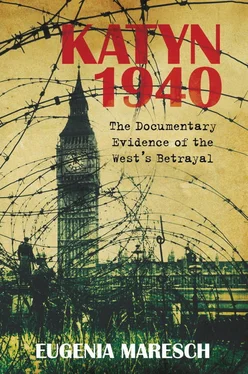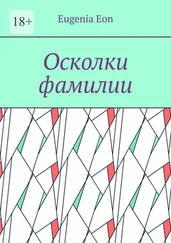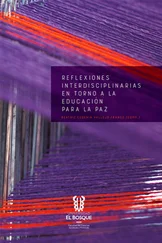Hankey had contacts with prominent Poles in Warsaw, among them Skarżyński, Secretary General of the PCK , whom he regarded as ‘an exceptionally trustworthy and honest man’. Because of its sensitivity, Hankey decided to despatch the lengthy report to London without translation from the Polish. It consisted of two parts; one, the official version, written in June 1943 while participating in the investigation at the insistence of the Germans and the second, more personal and confidential, written in the summer of 1945 just before his escape from Poland on 10 May 1946.
Skarżyński wrote the second part because he feared arrest by the Polish communistled security police (UB) who in collaboration with the NKVD were looking for everyone involved with Katyn visits. He had already been interrogated three times by Judge Procurator Karol Szwarc on behalf of the Ministry of Justice in Warsaw. Szwarc informed him that the Polish communist authorities intended to carry out their own investigation of the Katyn affair, to prove that the Germans had committed the crime. Skarżyński realised that even after being dismissed from the Red Cross, he still felt morally bound to tell the truth and making a statement under duress was abhorrent to him.
As to the fate of the report, it was put away as a historical document, of not much relevance to post-war issues, until it was rediscovered in the East European and Soviet Department (EE&SD) of the FCO on 1 November 1972, more of which later.
Skarżyński escaped to the West with Hankey’s assistance and on reaching Paris, he slightly edited the report to make it more readable and added a new introduction marked ‘ Norymberga, maj 1946 ’, presumably while temporarily stopping there. These narrative alterations do not interfere with the facts, which remain unaltered. While in Paris, Skarżyński made another deposition [17] PISM KOL 12/4/19 SOW17/46 a typed protocol of events by Kazimierz Skarżyński (signed by Judge Zygmunt Kindler) Paris, 3 September 1946.
before the military Judge Advocate, Captain Zygmunt Kindler, on 3 September 1946. This report is different, as it deals mainly with what had happened after June 1943, when nine boxes of documents from Katyn arrived in Kraków and their subsequent loss in Germany. Dr Werner Beck, Director of the Institute under German management and assistant to Dr Buhtz, revealed the ultimate fate of these documents much later, in 1951, at the Congressional hearings when he disclosed that the boxes had been destroyed on his orders, on a Dresden railway siding, just before the Red Army occupied the city.
Skarżyński’s Paris deposition contains the information that during his visit to Katyn, he was surprised to see an Auxiliary Police unit of Polish NCOs, created by the Germans and brought from the region of Lwów to carry out guard duty over the graves. From his report, we learn that there must have been a serious disagreement between him and Dr Marian Wodziński, the forensic medicine specialist, whose report carried more weight than the two Red Cross envoys put ‘in charge’ by Skarżyński, namely Hugon Kassur and Jerzy Wodzinowski, quoted in some publications as doctors.
His personal reminiscences of his short stay (15–17 April) at Katyn complements Dr Wodziński’s technical report, which was quoted freely but without attribution to him in the ‘Facts and Documents’ report of 1946. The two reports are to be considered as the most vital Polish evidence in establishing the truth about Katyn. The young pathologist Dr Wodziński had performed the exhumation work on seven mass graves for five long weeks. His report is informative and technical and encompasses all other events and visits to Katyn, including that made by a group of British and American PoWs.
News received via the BBC radio monitoring system [18] TNA HS 4/137 typescript copy of a message received ‘by most secret means’ from a British PoW in Germany on 2 May 1943, followed by a BBC monitoring report of 26th May 1943, of a German propaganda ( Weichsel ) broadcast in Russian for the Russians.
of enforced visits by the PoWs to Katyn alarmed the British, as the broadcast expressed the convictions of the Anglo-American group that the Soviets were the guilty party. The last part of the radio message is unclear due to bad reception. An extensive search for the reported conversation between ‘Ivanov’ and ‘Crighton’ has drawn a blank. Otherwise the message reads:
On 12th May, delegates of English and American prisoners of war were admitted to Smolensk to inspect the graves of the 12,000 Polish officers who were shot by the Bolsheviks. The delegation consisted of an English Lieutenant [probably Lt Col F.P. Stevenson], an English Staff Doctor [Gilder], an American Colonel [Van Vliet], an American Captain [Stewart] and also four English N.C.Os. This delegation was given the possibility of becoming acquainted, immediately after their arrival, with Russian volunteers, who were spending their leave in Smolensk. The Anglo-American prisoners of war were convinced that the Russian volunteers were completely independent and were in no way under German pressure.
After having inspected the Katyn graves, the English Lieutenant declared that he was facing the truth. The investigation of the Katyn crime should be the concern of (one sentence inaudible)… the Parliaments of all countries. The crime of Katyn is so base a Bolshevik action that the whole world should be told about it.
After this, the English Lieutenant [Crighton?] with the help of the English staff Doctor, who knows Russian well, talked with the Lieutenant of the Russian army of Liberation, Ivanov. [Interview between Crighton(?) and Ivanov follows].
The visit became one of the most well known aspects of the story of Katyn, gaining notoriety during the US Congressional Committee hearings in 1952. Apparently there were two original reports, one written by Captain Stanley Stewart Browne Gilder (RAMC) Royal Army Medical Corps and another by Lieutenant Colonel John H. Van Vliet Jr, which could not be produced as evidence as it was ‘lost’ somewhere in the Pentagon. At the Congressional enquiry [19] TNA FO 371/100719, The Katyn Forest Massacre Hearings, Select Committee to conduct an investigation of the facts, evidence and circumstances of the Katyn Forest Massacre, second session Washington D. C., 4 February 1952, pp. 31–59.
Major General Clayton Bissell, the former Assistant Chief of Staff, Army Intelligence (G-2) mentioned in passing that a British officer, who likewise was taken to Katyn by the Nazis, wrote a report that ‘substantiates in effect the statement of Van Vliet’, which was forwarded to Julius Holmes, Assistant Secretary of State in London, on 25 May 1945, something he denied during the 1952 US Select Committee hearings.
The unknown British officer, Captain Stanley Gilder, was in fact a medical officer who after returning to the Feld Lazarette in Oflag V B at Rottenmunster informed the British authorities that he had been to Katyn under protest, afraid that German propaganda might portray him as a willing participant. He submitted a written report, probably at the instigation of a representative of the International Red Cross who visited the PoW camp on 27 July 1943. A copy dated 30 May 1944 was forwarded to the British Legation in Berne on 3 July 1944. In the British Archives, there are two versions of the report, the latter, which is reproduced here, is more detailed and comes from a file held by the American authorities. [20] TNA FO 916/827 and 828 British Legation in Berne despatch 6605, 20 August 1943 for the FO, under ref KW 2/4 Information concerning journey to Katyn of Captain Stanley B. Gilder, includes a two-page typed copy of Gilder’s report dated 30 May 1944 of the British and American PoW visit to Katyn, together with five photographs, which was delivered to the British Legation in Berne on 3 July 1944; FO 916/828 ref MI9/BM/973, another account of the same visit sent by Director of Prisoners of War, War Office dated 22 November 1944 to FO Political Intelligence Department as well as the South African Union Defence Force representative Lt Col C.H.S. Runge at South Africa House in London.
Читать дальше












